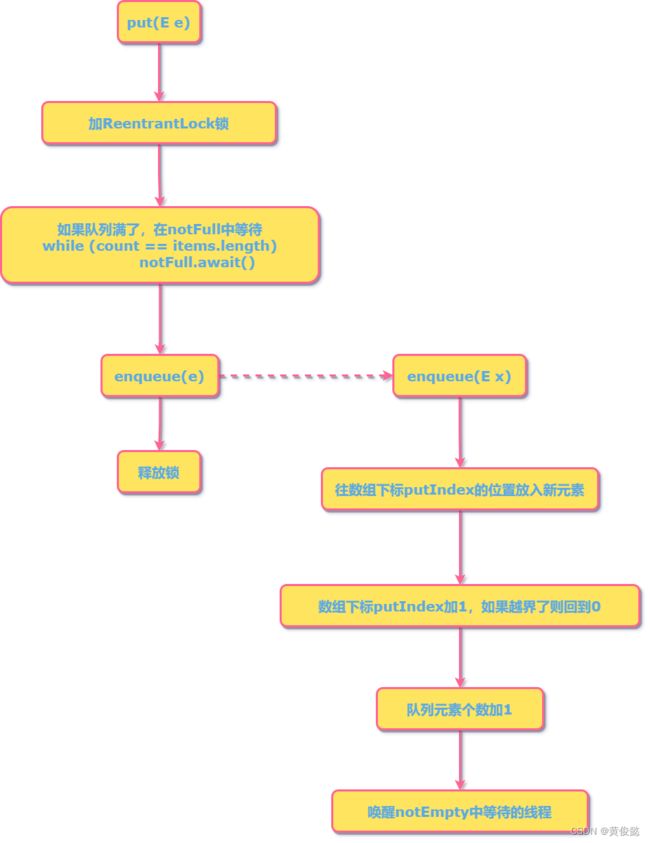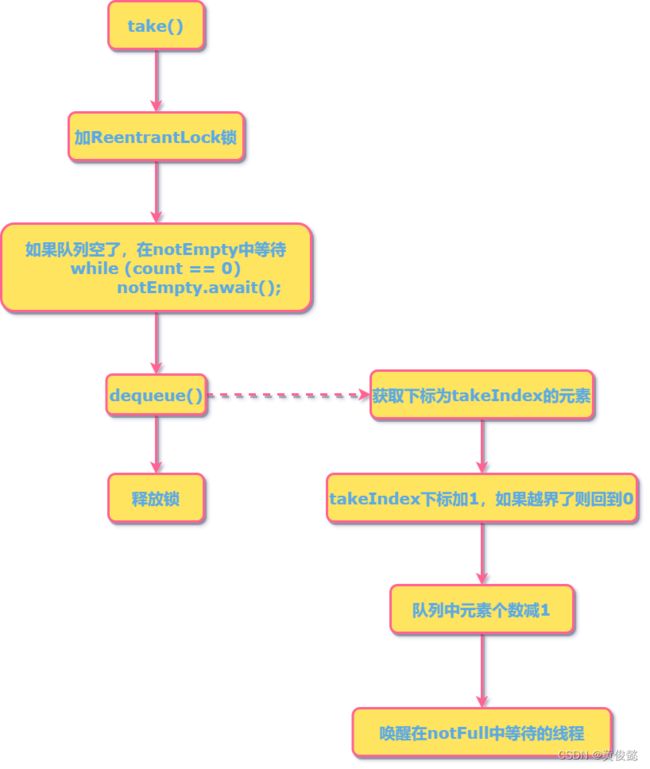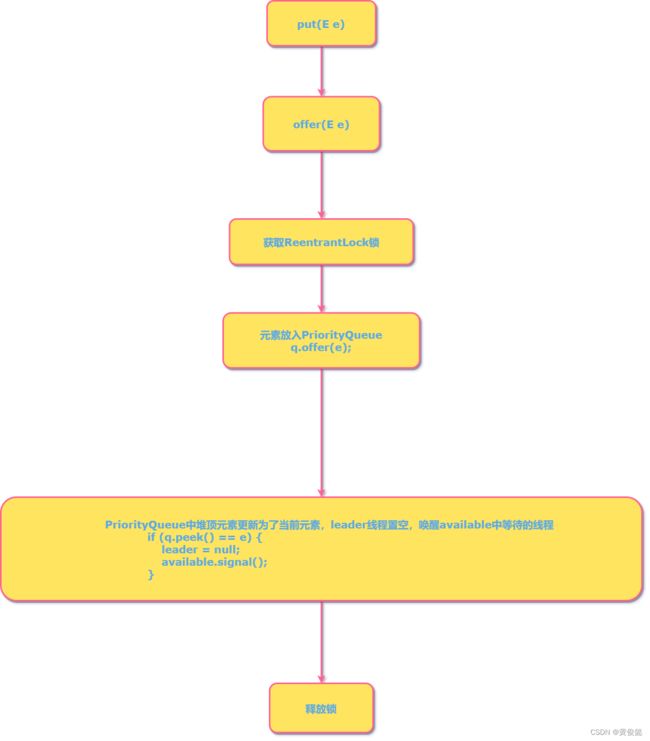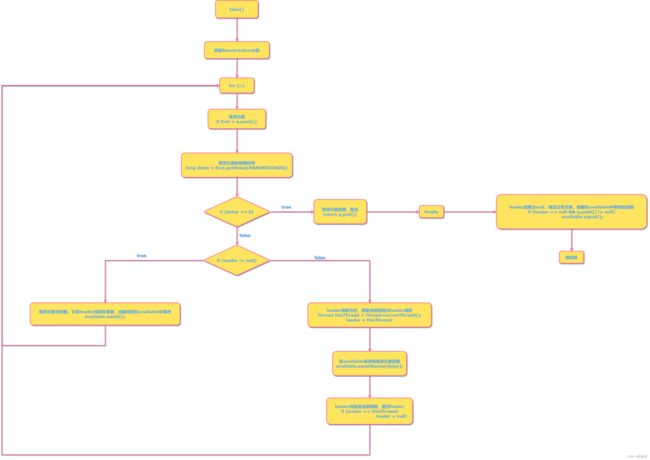图解java.util.concurrent并发包源码系列——各种各样的阻塞队列BlockingQueue一套带走(ノ`Д)ノ!!!
图解java.util.concurrent并发包源码系列——各种阻塞队列BlockingQueue一套带走
- ArrayBlockingQueue
- LinkedBlockingQueue
- PriorityBlockingQueue
- DelayQueue
- SynchronousQueue
BlockingQueue是java.util.concurrent并发包提供的一个可以在高并发场景下使用的阻塞队列的接口,它的实现类包括ArrayBlockingQueue、LinkedBlockingQueue、DelayQueue等等。
BlockingQueue在各种使用Java编写的分布式或微服务中间件中使用得比较多。为了提升性能,这些中间件一般会把一些比较耗时的操作滞后,封装一个任务对象放入到BlockingQueue中,用一个后台线程去轮询这个BlockingQueue,而前方负责接收请求的接口把任务放入BlockingQueue后就响应客户端操作成功。
ArrayBlockingQueue
成员变量:
public class ArrayBlockingQueue<E> extends AbstractQueue<E>
implements BlockingQueue<E>, java.io.Serializable {
// 存放队列元素的数组
final Object[] items;
// 下一个从队列中获取元素的数组下标
int takeIndex;
// 下一个放入队列元素的是数组下标
int putIndex;
// 队列元素个数
int count;
// 重入锁,保证线程安全
final ReentrantLock lock;
// 条件队列,当从队列中获取元素时取不到元素,线程会在notEmpty中等待
private final Condition notEmpty;
// 条件队列,当往队列中放入元素时没有空位,线程会在notFull中等待
private final Condition notFull;
}
ArrayBlockingQueue用一个数组保存放入到队列中的元素,然后有两个int类型的变量takeIndex、putIndex,分别记录下一次从数组中获取元素、放入元素的位置。
ArrayBlockingQueue有一个ReentrantLock,当从队列中获取元素或放入元素时,要先获取到ReentrantLock锁。
如果一个线程从ArrayBlockingQueue中获取元素时,发现ArrayBlockingQueue已经空了,那么这个线程会在notEmpty条件队列中等待。
如果一个线程往ArrayBlockingQueue中放入元素时,发现ArrayBlockingQueue已经满了,那么这个线程会在notFull条件队列中等待。
java.util.concurrent.ArrayBlockingQueue#put:
public void put(E e) throws InterruptedException {
checkNotNull(e);
// 加ReentrantLock锁
final ReentrantLock lock = this.lock;
lock.lockInterruptibly();
try {
// 如果队列满了,在notFull中等待
while (count == items.length)
notFull.await();
// 插入元素
enqueue(e);
} finally {
// 释放锁
lock.unlock();
}
}
java.util.concurrent.ArrayBlockingQueue#enqueue:
private void enqueue(E x) {
// 往数组下标putIndex的位置放入新元素
final Object[] items = this.items;
items[putIndex] = x;
// 数组下标putIndex加1,如果越界了则回到0
if (++putIndex == items.length)
putIndex = 0;
// 队列元素个数加1
count++;
// 唤醒notEmpty中等待的线程
notEmpty.signal();
}
java.util.concurrent.ArrayBlockingQueue#take:
public E take() throws InterruptedException {
// 加ReentrantLock锁
final ReentrantLock lock = this.lock;
lock.lockInterruptibly();
try {
// 如果队列空了,在notEmpty中等待
while (count == 0)
notEmpty.await();
// 从队列取元素
return dequeue();
} finally {
// 释放锁
lock.unlock();
}
}
java.util.concurrent.ArrayBlockingQueue#dequeue
private E dequeue() {
final Object[] items = this.items;
@SuppressWarnings("unchecked")
// 获取下标为takeIndex的元素
E x = (E) items[takeIndex];
items[takeIndex] = null;
// takeIndex下标加1,如果越界了则回到0
if (++takeIndex == items.length)
takeIndex = 0;
// 队列中元素个数减1
count--;
if (itrs != null)
itrs.elementDequeued();
// 唤醒在notFull中等待的线程
notFull.signal();
return x;
}
LinkedBlockingQueue
成员变量:
public class LinkedBlockingQueue<E> extends AbstractQueue<E>
implements BlockingQueue<E>, java.io.Serializable {
// LinkedBlocking的节点内部类
static class Node<E> {
// 节点中的元素
E item;
// 下一个节点(单向链表)
Node<E> next;
Node(E x) { item = x; }
}
// 队列容量
private final int capacity;
// 当前队列大小
private final AtomicInteger count = new AtomicInteger();
// 链表头指针
transient Node<E> head;
// 链表尾指针
private transient Node<E> last;
// 从队列中获取元素时要加的锁
private final ReentrantLock takeLock = new ReentrantLock();
// 从队列中获取元素时队列空了,会在notEmpty条件队列中等待
private final Condition notEmpty = takeLock.newCondition();
// 往队列中放入元素时要加的锁
private final ReentrantLock putLock = new ReentrantLock();
// 往队列中放入元素时队列满了,会在notFull条件队列中等待
private final Condition notFull = putLock.newCondition();
}
LinkedBlockingQueue使用单向链表保存放入到队列中的元素,元素会被包装成一个Node节点,放入到链表中。
Node是定义在LinkedBlockingQueue中的一个内部类,有一个next指针指向下一个节点。
LinkedBlockingQueue有一个头指针head和一个尾指针last,获取元素时元素从头部出队并修改head指针,放入元素时元素从尾部入队并修改last指针。
LinkedBlockingQueue有两个ReentrantLock,分表是takeLock和putLock,takeLock在从队列中获取元素时使用,putLock在往队列中放入元素时使用。
LinkedBlockingQueue也有两个Condition,notEmpty和notFull。当一个线程从队列中获取元素时,队列是空的,那么线程要在notEmpty条件队列中等待。当一个线程往队列中放入元素时,队列是满的,那么线程要在notFull条件队列中等待。
java.util.concurrent.LinkedBlockingQueue#put:
public void put(E e) throws InterruptedException {
if (e == null) throw new NullPointerException();
int c = -1;
Node<E> node = new Node<E>(e);
final ReentrantLock putLock = this.putLock;
final AtomicInteger count = this.count;
// 加putLock锁
putLock.lockInterruptibly();
try {
// 如果队列满了,在notFull中等待
while (count.get() == capacity) {
notFull.await();
}
// 元素入队列
enqueue(node);
// count加1然后返回count原来的值
c = count.getAndIncrement();
// 队列还未满,唤醒notFull中等待的线程
if (c + 1 < capacity)
notFull.signal();
} finally {
// 释放锁
putLock.unlock();
}
// 如果原来的队列是空的,唤醒在notEmpty中等待的线程
if (c == 0)
signalNotEmpty();
}
java.util.concurrent.LinkedBlockingQueue#enqueue:
private void enqueue(Node<E> node) {
// node放入队列尾部,更新last指针
last = last.next = node;
}
java.util.concurrent.LinkedBlockingQueue#signalNotEmpty:
private void signalNotEmpty() {
final ReentrantLock takeLock = this.takeLock;
// 加takeLock锁
takeLock.lock();
try {
// 唤醒notEmpty中等待的线程
notEmpty.signal();
} finally {
// 释放锁
takeLock.unlock();
}
}
java.util.concurrent.LinkedBlockingQueue#take:
public E take() throws InterruptedException {
E x;
int c = -1;
final AtomicInteger count = this.count;
final ReentrantLock takeLock = this.takeLock;
// 获取takeLock锁
takeLock.lockInterruptibly();
try {
// 如果队列空了,在notEmpty中等待
while (count.get() == 0) {
notEmpty.await();
}
// 从队列取元素
x = dequeue();
// count减1,然后返回原来的count
c = count.getAndDecrement();
// 队列还没空,唤醒在notEmpty中等待的线程
if (c > 1)
notEmpty.signal();
} finally {
// 释放锁
takeLock.unlock();
}
// 如果原来队列是满的,唤醒在notFull等待的线程
if (c == capacity)
signalNotFull();
return x;
}
java.util.concurrent.LinkedBlockingQueue#dequeue:
private E dequeue() {
// 取出头节点
Node<E> h = head;
// 头节点的后继节点
Node<E> first = h.next;
h.next = h;
// 更新头指针
head = first;
// 返回节点中的元素item
E x = first.item;
first.item = null;
return x;
}
java.util.concurrent.LinkedBlockingQueue#signalNotFull:
private void signalNotFull() {
final ReentrantLock putLock = this.putLock;
// 获取putLock
putLock.lock();
try {
// 唤醒在notFull中等待的线程
notFull.signal();
} finally {
// 释放锁
putLock.unlock();
}
}
PriorityBlockingQueue
成员变量:
public class PriorityBlockingQueue<E> extends AbstractQueue<E>
implements BlockingQueue<E>, java.io.Serializable {
// 堆数组(小顶堆)
private transient Object[] queue;
// 队列大小
private transient int size;
// 比较器
private transient Comparator<? super E> comparator;
// 从队列中存取元素,都要加ReentrantLock锁
private final ReentrantLock lock;
// 从队列中取元素,队列空了,线程要在notEmpty条件队列中等待
private final Condition notEmpty;
// 自旋锁,数组扩容时使用
private transient volatile int allocationSpinLock;
}
PriorityBlockingQueue是优先级阻塞队列,在java.util包中还有一个PriorityQueue优先级队列,PriorityBlockingQueue是它的升级版。当一个元素放入优先级队列中,元素会自动根据预定义的优先级比较策略进行排序,排在队列头部的元素是优先级最高的,每次从队列中获取元素时都会从头部中获取。PriorityBlockingQueue相当于是并发场景下线程安全的PriorityQueue。
PriorityBlockingQueue用一个数组queue保存放入到队列中的元素,数组queue是一个堆数组,也就是用一个数组去替代二叉堆,如果一个节点是 queue[n],它的左子节点和右子节点就分别是 queue[2n+1] 和 queue[2(n+1)]。
PriorityBlockingQueue每次存取元素后,都要做堆调整,以满足预定义的优先级比较策略下元素的排序。
PriorityBlockingQueue可以接收一个比较器Comparator,我们可以通过自定义比较器的比较逻辑来自定义PriorityBlockingQueue中元素的排序策略。如果不传递比较器给PriorityBlockingQueue,PriorityBlockingQueue就使用Comparable接口的compareTo(T o)方法进行排序,此时如果放入PriorityBlockingQueue的元素没有实现Comparable接口,就会抛出ClassCastException异常。
从PriorityBlockingQueue中存取元素,都要加ReentrantLock锁。
如果一个线程要从PriorityBlockingQueue中获取元素,而此时正好PriorityBlockingQueue中没有元素,那么该线程要在notEmpty条件队列中等待。
PriorityBlockingQueue要进行queue数组的扩容时,会加自旋锁,通过CAS修改allocationSpinLock变量为1(原来是0),加锁成功才能进行数组扩容操作。

java.util.concurrent.PriorityBlockingQueue#put:
public void put(E e) {
offer(e);
}
java.util.concurrent.PriorityBlockingQueue#offer(E):
public boolean offer(E e) {
if (e == null)
throw new NullPointerException();
// 加ReentrantLock锁
final ReentrantLock lock = this.lock;
lock.lock();
int n, cap;
Object[] array;
// 如果队列满了,要进行扩容
while ((n = size) >= (cap = (array = queue).length))
tryGrow(array, cap);
try {
Comparator<? super E> cmp = comparator;
// 比较器是空,使用Comparable接口进行元素比较,做堆的向上调整
if (cmp == null)
siftUpComparable(n, e, array);
// 比较器不为空,使用比较器进行元素比较,做堆的向上调整
else
siftUpUsingComparator(n, e, array, cmp);
// 队列元素个数加1
size = n + 1;
// 唤醒在notEmpty中等待的线程
notEmpty.signal();
} finally {
// 释放锁
lock.unlock();
}
return true;
}
java.util.concurrent.PriorityBlockingQueue#tryGrow:
private void tryGrow(Object[] array, int oldCap) {
// 先释放锁,等扩容完了重新获取
lock.unlock();
Object[] newArray = null;
// CAS获取自旋锁
if (allocationSpinLock == 0 &&
UNSAFE.compareAndSwapInt(this, allocationSpinLockOffset,
0, 1)) {
try {
// 扩容,如果老数组长度小于64,新数组长度加2,否则扩容1.5倍
int newCap = oldCap + ((oldCap < 64) ?
(oldCap + 2) :
(oldCap >> 1));
// 如果新数组长度超过最大限制,那么修改扩容后长度为老数组长度加1,如果还是超了,那么抛异常
if (newCap - MAX_ARRAY_SIZE > 0) {
int minCap = oldCap + 1;
if (minCap < 0 || minCap > MAX_ARRAY_SIZE)
throw new OutOfMemoryError();
newCap = MAX_ARRAY_SIZE;
}
// 创建新数组
if (newCap > oldCap && queue == array)
newArray = new Object[newCap];
} finally {
// 释放自旋锁
allocationSpinLock = 0;
}
}
// 扩容完,还没完成数组元素拷贝,其他线程要让出时间片
if (newArray == null)
Thread.yield();
// 重新获取锁
lock.lock();
if (newArray != null && queue == array) {
// 新数组赋值到queue
queue = newArray;
// 完成数组元素拷贝
System.arraycopy(array, 0, newArray, 0, oldCap);
}
}
java.util.concurrent.PriorityBlockingQueue#siftUpComparable:
private static <T> void siftUpComparable(int k, T x, Object[] array) {
// 类型强制转换,转成Comparable
Comparable<? super T> key = (Comparable<? super T>) x;
// 向上调整,直到来到顶部,或者找到合适的位置
while (k > 0) {
// 当前位置k的父元素位置
int parent = (k - 1) >>> 1;
// 获取父元素
Object e = array[parent];
// 利用Comparable接口的compareTo方法进行比较
if (key.compareTo((T) e) >= 0)
// 因为是小顶堆,如果key.compareTo((T) e)返回大于等于0,那么当前位置k就是元素x要放入的位置
break;
// 把父元素往下拽
array[k] = e;
// 更新下标k为父元素的下标,用于下一轮比较
k = parent;
}
// 把当前元素放入位置k
array[k] = key;
}
java.util.concurrent.PriorityBlockingQueue#siftUpUsingComparator:
private static <T> void siftUpUsingComparator(int k, T x, Object[] array,
Comparator<? super T> cmp) {
// 向上调整,直到来到顶部,或者找到合适的位置
while (k > 0) {
// 当前位置k的父元素位置
int parent = (k - 1) >>> 1;
// 获取父元素
Object e = array[parent];
// 利用比较器进行比较
if (cmp.compare(x, (T) e) >= 0)
// 因为是小顶堆,如果cmp.compare(x, (T) e)返回大于等于0,那么当前位置k就是元素x要放入的位置
break;
// 把父元素往下拽
array[k] = e;
// 更新下标k为父元素的下标,用于下一轮比较
k = parent;
}
// 把当前元素放入位置k
array[k] = x;
}
java.util.concurrent.PriorityBlockingQueue#take:
public E take() throws InterruptedException {
// 加ReentrantLock锁
final ReentrantLock lock = this.lock;
lock.lockInterruptibly();
E result;
try {
// 从队列中获取元素,没有元素就在notEmpty中等待
while ( (result = dequeue()) == null)
notEmpty.await();
} finally {
// 释放锁
lock.unlock();
}
return result;
}
private E dequeue() {
int n = size - 1;
// 队列没有元素,返回null
if (n < 0)
return null;
else {
Object[] array = queue;
// 取出堆顶元素,作为返回结果
E result = (E) array[0];
// 取出堆底元素
E x = (E) array[n];
// 堆底置为null
array[n] = null;
Comparator<? super E> cmp = comparator;
// 如果比较器为空,用Comparable进行元素比较,做堆的向下调整
if (cmp == null)
siftDownComparable(0, x, array, n);
// 如果比较器不为空,用比较器进行元素比较,做堆的向下调整
else
siftDownUsingComparator(0, x, array, n, cmp);
// 更新队列大小
size = n;
// 返回结果
return result;
}
}
java.util.concurrent.PriorityBlockingQueue#siftDownComparable:
private static <T> void siftDownComparable(int k, T x, Object[] array,
int n) {
if (n > 0) {
// 类型强转,转成Comparable
Comparable<? super T> key = (Comparable<? super T>)x;
// 计算堆底位置
int half = n >>> 1;
// 循环进行堆的向下调整,直到来到堆底
while (k < half) {
// 左孩子位置
int child = (k << 1) + 1;
// 获取左孩子
Object c = array[child];
// 右孩子位置
int right = child + 1;
// 两个孩子先pk,保存胜出的孩子和胜出孩子的位置
if (right < n &&
((Comparable<? super T>) c).compareTo((T) array[right]) > 0)
c = array[child = right];
// 当前元素跟胜出的孩子比,如果比胜出的孩子还小(更优先),那么位置k就是目标位置
if (key.compareTo((T) c) <= 0)
break;
// 把胜出孩子往上提
array[k] = c;
// 更新位置k,用于下一轮比较
k = child;
}
// 当前元素放入目标位置
array[k] = key;
}
}
java.util.concurrent.PriorityBlockingQueue#siftDownUsingComparator:
private static <T> void siftDownUsingComparator(int k, T x, Object[] array,
int n,
Comparator<? super T> cmp) {
if (n > 0) {
// 计算堆底位置
int half = n >>> 1;
// 循环进行堆的向下调整,直到来到堆底
while (k < half) {
// 左孩子位置
int child = (k << 1) + 1;
// 获取左孩子
Object c = array[child];
// 右孩子位置
int right = child + 1;
// 两个孩子先pk,保存胜出的孩子和胜出孩子的位置
if (right < n && cmp.compare((T) c, (T) array[right]) > 0)
c = array[child = right];
// 当前元素跟胜出的孩子比,如果比胜出的孩子还小(更优先),那么位置k就是目标位置
if (cmp.compare(x, (T) c) <= 0)
break;
// 把胜出孩子往上提
array[k] = c;
k = child;
}
// 当前元素放入目标位置
array[k] = x;
}
}
DelayQueue
成员变量:
public class DelayQueue<E extends Delayed> extends AbstractQueue<E>
implements BlockingQueue<E> {
// 每一个从队列中存取元素的线程,都要先获取lock锁
private final transient ReentrantLock lock = new ReentrantLock();
// 优先级队列,根据元素到期时间从小到大排序
private final PriorityQueue<E> q = new PriorityQueue<E>();
// leader线程,等待PriorityQueue中堆顶元素到期的线程
private Thread leader = null;
// 条件队列,队列为空或者堆顶元素未到期,都会在这里等待
private final Condition available = lock.newCondition();
}
DelayQueue是延时队列,每个放入DelayQueue中的元素都有一个到期时间,只有元素到期了才能从DelayQueue中取走,否则线程要在条件队列available中进行等待。
DelayQueue有一个ReentrantLock锁,每个从队列中存取元素的线程,都要先获取ReentrantLock锁。
DelayQueue使用一个PriorityQueue保存放入到队列中的元素,PriorityQueue根据元素的到期时间从小到大进行排序,堆顶元素是最快到期的元素。
DelayQueue中有一个leader线程,保存等待堆顶元素到期取走的线程。当leader线程成功获取到堆顶元素会,会唤醒等待在available中的线程。
java.util.concurrent.DelayQueue#put:
public void put(E e) {
offer(e);
}
java.util.concurrent.DelayQueue#offer(E):
public boolean offer(E e) {
// 获取ReentrantLock锁
final ReentrantLock lock = this.lock;
lock.lock();
try {
// 元素放入PriorityQueue
q.offer(e);
// PriorityQueue中堆顶元素更新为了当前元素,leader线程置空,唤醒available中等待的线程
if (q.peek() == e) {
leader = null;
available.signal();
}
return true;
} finally {
// 释放锁
lock.unlock();
}
}
java.util.concurrent.DelayQueue#take:
public E take() throws InterruptedException {
// 获取ReentrantLock锁
final ReentrantLock lock = this.lock;
lock.lockInterruptibly();
try {
for (;;) {
// 堆顶元素
E first = q.peek();
// 队列为空,线程在available中等待
if (first == null)
available.await();
else {
// 堆顶元素的到期时间
long delay = first.getDelay(NANOSECONDS);
// 堆顶元素到期,取走
if (delay <= 0)
return q.poll();
first = null;
// 堆顶元素未到期,又有leader线程在等着,当前线程在available中等待
if (leader != null)
available.await();
else {
// leader线程为空,更新当前线程为leader线程
Thread thisThread = Thread.currentThread();
leader = thisThread;
try {
// 在available等待到堆顶元素到期
available.awaitNanos(delay);
} finally {
// leader线程是当前线程,置空leader
if (leader == thisThread)
leader = null;
}
}
}
}
} finally {
// leader线程为null,堆顶又有元素,唤醒在available中等待的线程
if (leader == null && q.peek() != null)
available.signal();
// 释放锁
lock.unlock();
}
}
SynchronousQueue
SynchronousQueue比较特别,它是一个不存储元素的队列。每个往SynchronousQueue放入元素的线程,都要阻塞等待直到有线程从SynchronousQueue中取走该元素。每个从SynchronousQueue中获取元素的线程都要阻塞等待,直到有线程往SynchronousQueue中放入元素。











